Florida is home to a stunning variety of trees that bring color and life to its landscapes throughout the year. Among these, yellow-flowering trees stand out for their bright, cheerful blooms that capture attention from afar. From city streets to natural parks, these golden blossoms create a vibrant contrast against the greenery.
Spring and summer are the best seasons to spot these radiant trees. Each species has its own unique flower shape, bloom pattern, and growth habit, making them easy to identify once you know what to look for. Gardeners and nature enthusiasts alike often seek them out for their beauty and the wildlife they attract.
In this guide, we’ll introduce seven of the most remarkable yellow-flowering trees in Florida. You’ll learn how to identify each one, see clear pictures, and discover interesting facts about their characteristics and habitats. By the end, you’ll be ready to recognize these sunny trees on your next walk or drive through the Sunshine State.
Table of Contents
Popular Yellow-Flowering Trees in Florida
Golden Trumpet Tree (Handroanthus chrysotrichus)
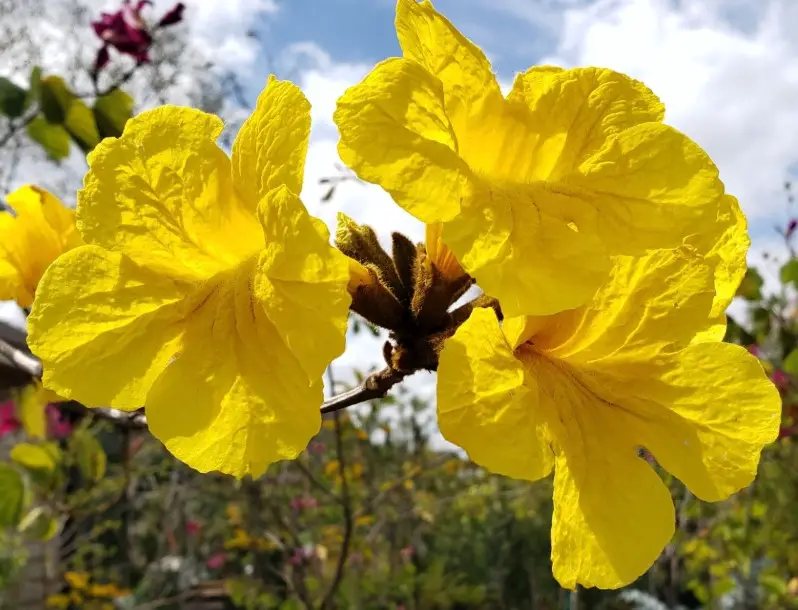
The Golden Trumpet Tree is a tropical beauty known for its striking golden-yellow, trumpet-shaped flowers. These blooms often appear in late winter to early spring, sometimes before the leaves emerge, creating a dramatic splash of color in any landscape. The flowers attract pollinators such as bees and hummingbirds, making it a vibrant addition for wildlife enthusiasts. Its bark is grayish-brown and develops a rough texture as the tree matures.
In terms of identification, this tree has a broad, rounded canopy with pinnate leaves composed of several glossy leaflets. The flowers are large, trumpet-like, and grow in clusters at the ends of branches, making them highly visible from a distance. During the blooming period, fallen flowers often carpet the ground in bright yellow, enhancing its ornamental appeal.
The Golden Trumpet Tree can reach heights of 25–35 feet and spread almost equally wide, forming a full, rounded shape. It prefers full sun exposure and well-draining soil. Though it grows relatively quickly, it remains manageable with proper pruning. This tree thrives in USDA zones 10–11, making it ideal for most areas of South Florida.
For planting and care, it is recommended to water young trees regularly until established, after which they are moderately drought-tolerant. Fertilization with a balanced, slow-release fertilizer encourages healthy growth and abundant flowering. Prune any dead or weak branches in late winter after the flowering period to maintain a strong structure.
Yellow Trumpet Tree (Handroanthus umbellatus)

The Yellow Trumpet Tree is closely related to the Golden Trumpet but is more adaptable to slightly cooler climates. It features brilliant yellow, trumpet-shaped flowers that bloom in late winter to early spring, adding early-season color to gardens. Its flowers attract bees, butterflies, and hummingbirds, providing both beauty and ecological benefits. The tree’s bark is gray and somewhat furrowed, giving it a sturdy appearance even in young specimens.
This species can be identified by its pinnate leaves, which are smaller and more delicate than those of the Golden Trumpet. Flowers are clustered at the branch tips, forming dense sprays of vibrant yellow. The overall silhouette of the tree is oval to rounded, making it a versatile choice for both residential and public landscapes.
The Yellow Trumpet Tree grows to about 25–30 feet in height with a similar spread, forming a moderately sized canopy that provides dappled shade. It prefers full sun and well-drained soil and can tolerate occasional drought once established. This tree is hardy in USDA zones 9b–11, making it suitable for northern and central regions of Florida where occasional cooler weather occurs.
For planting and care, water young trees consistently for the first two years to encourage deep root development. Mulching around the base helps retain moisture and suppress weeds. Fertilize annually with a slow-release formula to support growth and flowering. Light pruning after blooming will improve structure and prevent overcrowding of branches.
Silver Trumpet Tree (Handroanthus caraiba)
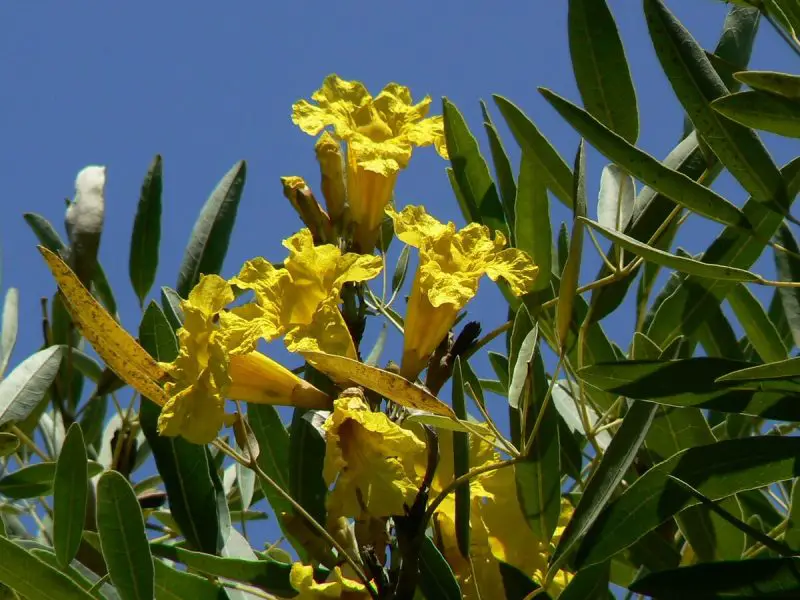
The Silver Trumpet Tree is an ornamental marvel, recognized for its large, bright yellow trumpet flowers and silvery-gray foliage. Its blooming season occurs in spring, creating a bold visual impact when combined with the light-colored bark and unique leaf texture. The flowers are highly attractive to pollinators and make excellent cut flowers for arrangements. This tree also adds year-round interest due to its textured bark and long-lasting foliage.
In terms of identification, the Silver Trumpet Tree has pinnate leaves with 5–7 leaflets, which have a slightly silvery hue underneath. Its flowers are trumpet-shaped and appear in loose clusters, prominently displayed against the silvery backdrop. The bark is light gray, smooth when young and becoming slightly ridged with age.
This species typically grows to 25–35 feet tall, with a similar width, forming a moderately dense, rounded canopy. It prefers full sun and well-draining soil and is moderately drought-tolerant once established. Frost-sensitive, it performs best in protected microclimates or in USDA zones 10–11, mainly in southern Florida.
For planting and care, provide ample space for the canopy to develop without crowding. Regular watering is necessary for young trees, while mature trees can tolerate short dry spells. Fertilize in early spring before flowering to encourage vigorous blooms. Prune lightly after flowering to maintain shape and remove any weak or crossing branches.
Golden Shower (Cassia fistula)
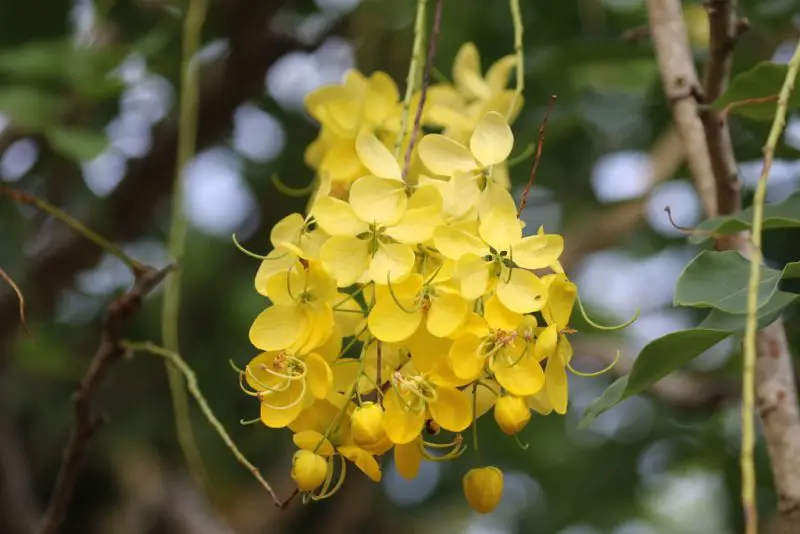
The Golden Shower tree is famous for its long, pendulous clusters of bright yellow flowers that cascade from the branches in late spring to early summer. These blooms often appear before the tree fully leafs out, creating a stunning curtain of color. The flowers attract bees, butterflies, and birds, making the tree a lively focal point in gardens and parks. Its smooth, grayish bark adds to its ornamental appeal even when not in bloom.
Identification of this tree is straightforward: it has pinnate leaves with 4–8 pairs of leaflets, and its flower clusters, known as racemes, can reach up to 20 inches long. The tree produces long, flat, brown seed pods that persist through the fall and winter, providing visual interest year-round.
Golden Shower trees can grow quite tall, reaching 33–66 feet in height with a wide-spreading canopy. They prefer full sun and thrive in well-drained soils. Though fast-growing, they require adequate space to accommodate their broad canopy. This species is hardy in USDA zones 10–11, favoring southern and central Florida climates.
For planting and care, young trees should be watered regularly until established. Mulching helps retain moisture and protects the roots. Fertilization in spring encourages healthy growth and abundant flowering. Light pruning after flowering helps maintain a balanced structure and removes any dead or weak branches.
Yellow Poinciana (Peltophorum pterocarpum)
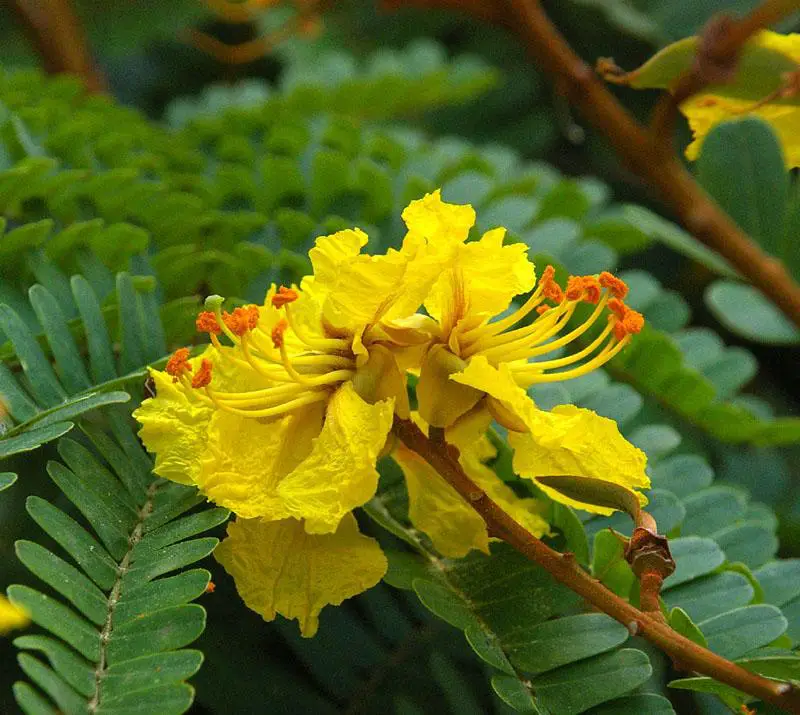
The Yellow Poinciana is a tropical tree admired for its large, frothy clusters of golden-yellow flowers, often appearing in summer. Its blooms have a faint, sweet fragrance that attracts bees and butterflies. The tree’s feathery leaves provide a delicate texture that contrasts beautifully with the bold, bright flowers. Its bark is smooth when young and becomes slightly fissured with age, adding to its visual interest.
This species can be identified by its bipinnate leaves, which create a lacy canopy, and by the clusters of bright yellow flowers that bloom at the branch tips. After flowering, it produces flat, brown seed pods that hang elegantly from the branches. The overall shape of the tree is wide and spreading, making it a striking specimen in large landscapes.
Yellow Poinciana trees grow 30–50 feet tall with an equally wide canopy. They prefer full sun exposure and well-drained soil but are adaptable to various soil types. Although moderately drought-tolerant once established, they thrive with occasional watering during prolonged dry periods. This tree is hardy in USDA zones 10–11, mainly thriving in South Florida’s warm, tropical climate.
For planting and care, it is best to plant the tree in open spaces to allow full canopy development. Regular watering supports young trees, while mature trees require minimal maintenance. Fertilize annually with a slow-release fertilizer to enhance flowering. Prune lightly after blooming to maintain a balanced canopy and remove any dead or crossing branches.
Golden Rain Tree (Koelreuteria paniculata)
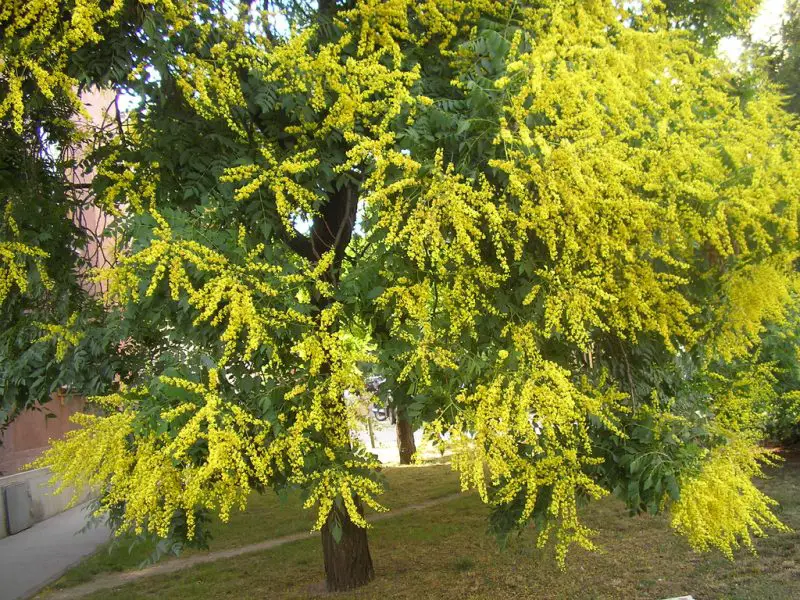
The Golden Rain Tree produces bright, star-shaped yellow flowers in late spring to summer, followed by unique, paper lantern-like seed pods that persist into the fall. Its blossoms attract bees, butterflies, and birds, providing both visual and ecological value. The bark is gray-brown and lightly textured, offering subtle contrast to the vibrant flowers.
In terms of identification, this tree has pinnate leaves with 11–25 leaflets, which often turn yellow or orange in fall. The flowers grow in large, showy panicles at the branch tips, creating a cascading effect. Its distinctive seed pods—three-lobed and inflated—add ornamental interest even after the flowering season ends.
Golden Rain Trees typically grow 30–40 feet tall with a spread of 25–35 feet, forming an open, rounded canopy. They prefer full sun and well-draining soil but are adaptable to various soil types and slightly drought-prone conditions. The species is hardy in USDA zones 7–10, making it suitable for northern, central, and southern parts of Florida.
For planting and care, water young trees regularly until roots establish. Mulch around the base to retain moisture and control weeds. Fertilize in early spring with a balanced fertilizer to encourage growth and abundant flowering. Pruning after flowering helps maintain shape and removes any dead or weak branches, keeping the canopy open and healthy.
Blue Palo Verde (Parkinsonia florida)
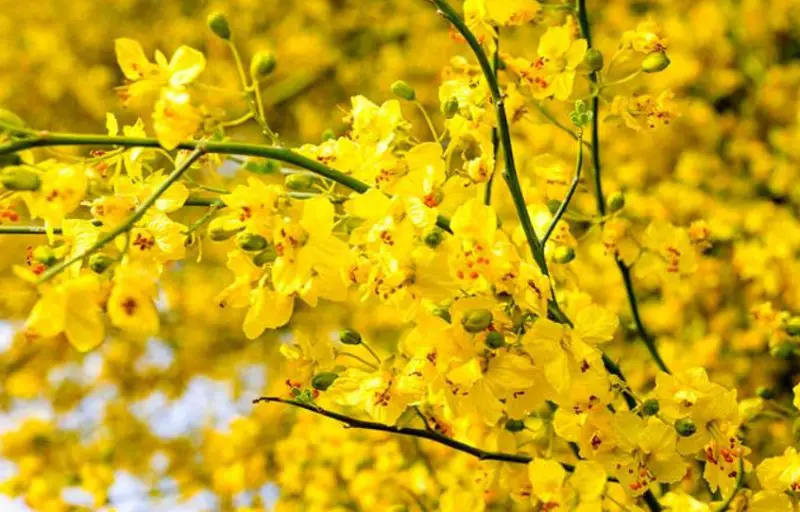
The Blue Palo Verde is a striking tree known for its bright yellow flowers and unique green bark. Blooming in spring to early summer, the flowers cover the tree in dense clusters, attracting pollinators such as bees and hummingbirds. Its green trunk and branches perform photosynthesis, giving the tree a distinctive, vibrant appearance even when leaves are sparse.
This tree is identifiable by its small, pinnate leaves and smooth, green bark. The yellow flowers are clustered at the ends of branches, forming a vivid contrast with the green stems. It produces small, slender seed pods that mature in late summer, adding further visual interest to the landscape.
Blue Palo Verde trees grow 20–25 feet tall with a similar canopy spread. They prefer full sun and well-draining, sandy soils. Highly drought-tolerant, they are ideal for xeriscaping and low-maintenance gardens. They thrive best in USDA zones 9–11, tolerating the warmer regions of Florida particularly well.
For planting and care, minimal watering is needed once the tree is established. Mulching helps protect roots from temperature fluctuations. Fertilize sparingly, as over-fertilization can reduce flowering. Light pruning after flowering removes any dead or crossing branches and maintains the tree’s natural, open canopy shape.
FAQs About Yellow-Flowering Trees in Florida
What are some popular yellow-flowering trees in Florida?
Some of the most popular yellow-flowering trees include the Golden Trumpet Tree (Handroanthus chrysotrichus), Yellow Trumpet Tree (Handroanthus umbellatus), Silver Trumpet Tree (Handroanthus caraiba), Golden Shower (Cassia fistula), Yellow Poinciana (Peltophorum pterocarpum), Golden Rain Tree (Koelreuteria paniculata), and Blue Palo Verde (Parkinsonia florida). Each tree offers vibrant yellow blooms that attract pollinators and enhance landscape aesthetics.
When do yellow-flowering trees bloom in Florida?
Blooming times vary by species. Golden Trumpet and Yellow Trumpet trees typically bloom in late winter to early spring. Silver Trumpet trees bloom in spring. Golden Shower trees bloom in late spring to early summer, while Yellow Poinciana shines in summer. Golden Rain Trees bloom in late spring to summer, and Blue Palo Verde flowers from spring to early summer.
How tall do yellow-flowering trees grow?
Height varies by species. Golden Trumpet, Yellow Trumpet, and Silver Trumpet trees generally grow 25–35 feet tall. Golden Shower can reach 33–66 feet, Yellow Poinciana 30–50 feet, Golden Rain Tree 30–40 feet, and Blue Palo Verde 20–25 feet. Canopy spreads are often similar to the tree’s height.
What are the ideal growing conditions for yellow-flowering trees?
Most yellow-flowering trees thrive in full sun and well-draining soil. Tropical species like Golden Trumpet, Silver Trumpet, Yellow Poinciana, and Golden Shower prefer USDA zones 10–11. Trees like Yellow Trumpet and Golden Rain are more cold-tolerant, suitable for zones 9–10. Adequate spacing and protection from frost are important for optimal growth.
How should I care for yellow-flowering trees?
Young trees need regular watering until established. Mulching around the base helps retain soil moisture and suppress weeds. Fertilize annually with a slow-release or balanced fertilizer to encourage healthy growth and flowering. Prune lightly after flowering to remove dead or weak branches and maintain a strong, attractive canopy.
Do yellow-flowering trees attract wildlife?
Yes. Many yellow-flowering trees attract pollinators such as bees, butterflies, and hummingbirds. Additionally, some species produce seed pods or fruits that provide food for birds. Planting these trees can enhance both the beauty and biodiversity of your garden.
Are yellow-flowering trees drought-tolerant?
Many species become moderately to highly drought-tolerant once established. For example, Blue Palo Verde and Golden Rain Tree are especially tolerant of dry conditions. Trees like Golden Trumpet and Cassia require more consistent watering during their first two years but adapt well after establishment.
Can yellow-flowering trees be planted in small spaces?
Some species, like Blue Palo Verde and Yellow Trumpet, are suitable for smaller landscapes due to their moderate height and canopy spread. Larger species like Golden Shower or Yellow Poinciana need more space to accommodate their broad, spreading canopies. Careful site selection ensures both aesthetic appeal and tree health.






